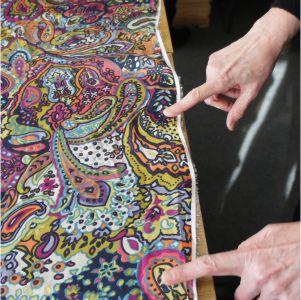Dressmaking, Guides
5 Best Ways to Sew Slippery Fabric For Dressmaking
Sewing With Slippery Fabric
5 best ways to sew slippery fabric:
- Use good quality pins to minimise snagging and pulling
- Pin inside the seam allowance to reduce marks to the main fabric surface
- Do not lift your fabric up off the table when cutting
- Consider trying a walking foot on your sewing machine
- Use a sharps (or microtextile) sewing machine needle
Shiny, slippery and drapey fabrics are well worth a little extra effort in cutting and dressmaking. Shiny fabrics drape differently to cotton and jersey dress fabric. They actually drape with soft wide folds and they reflect light – which makes them look shiny! Examples are polyester, satin, viscose, crepe and some jersey fabrics. The way these fabrics look and drape they make wonderful dressmaking fabrics.
How to pin your fabric
If your pattern requires you to cut with the fabric on the fold and with the selvedges together, it can be difficult to stop the fabric slipping..To hold the fabric firmly, always start by pinning the selvedge edges together approx every 25cms. This ensures the folded edge is smooth and on grain. If there is any sign of twisting or roping, (i.e. the fold does not sit flat but tries to twist), then un-pin the selvedge edges and re-fold the fabric (your fabric may have been cut a little off grain).
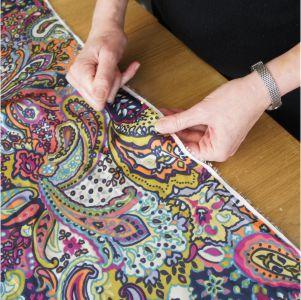
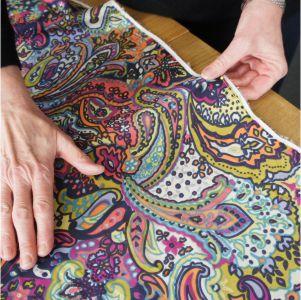
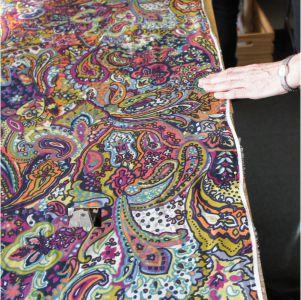
When you have your slippery fabric folded and pinned at the selvedge it is much easier to move on your cutting surface. If you have a long straight edge on your table or cutting board slide the fabric to the edge and keep an eye on it to make sure it doesn’t slide away from you.
Now start pinning your pattern to the fabric. If you have a very delicate fabric that catches or pulls easily keep all the pinning inside the seam allowances. Use as many pins as you need to prevent the fabric slipping away from the pattern when you are cutting. You will need more pins on curves or unusual shapes.
It makes sense to use really good quality pins that do not feel as if they are snagging or catching the fabric. A longer pin is a good idea too. Use pins that are a minimum of 30mm long. Our favourites are Prym extra long glass headed pins. They are a fantastic pin and it is well worth keeping them in a separate box so they do not get mixed in with other pins.
How to cut your fabric
To cut well, practice keeping your scissor touching the table. Do not lift your slippery fabric up off the table when cutting. This minimises the chance of the fabric moving.
With your slippery fabric securely pinned together and your scissors always held level on the table you should achieve trouble free cutting of your slippery dress fabric.
How to sew slippery fabric
You should be fine using your sewing machine to sew slippery fabric if you follow some simple principles:
You may need to increase the pressure on your presser foot as these types of fabric are very fine. This will help to stop the fabric sliding against itself and feeding evenly.
Try a walking foot. This screws onto your sewing machine and effectively walks the upper layer of fabric at the same time as the feed dogs are walking the lower layer of fabric. In saying this, we have found them a little clunky on thin fabrics. If you use a walking foot make sure it’s not crimping or wrinkling the fabric under the foot.
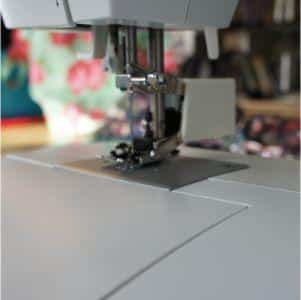
Use a sharps (or microtextile) sewing machine needle. These needles are thinner and finer than normal needles with a sharper point that is ideal for finer dressmaking fabrics. Remember, the lower the number of the needle, the thinner and finer it is (60 is the finest).
Use lots of good pins, to hold your fabric pieces together when sewing. Never sew over your pins! You can damage your needle point and cause snagging. Use more pins on slippery fabrics than you would on cotton. Keep checking that your fabric edges are together and the underneath layer has not slipped.
Always practice your sewing on some of the scraps. You will need to check that your needle is suitable for finer fabrics and always change to a new needle when starting a project on a delicate fabric as a used needle can snag or scar your project.
Most importantly; take your time! These fabrics do not like to be rushed but are well worth the extra effort and time taken on them. When we are looking for ideas and inspiration, one of the sites we love to look at is the Metropolitan Museum of Modern Art. They have an amazing archive of vintage dress pictures. To give you an idea of what you can find, just look here.
Enjoy More Sewing!

